This was published 10 months ago
I thought my seventh trip to Antarctica would be my last. But then ...
Where else on Earth could you kayak up close to whales and penguins – and see the world’s largest iceberg?
By Jennifer Byrne
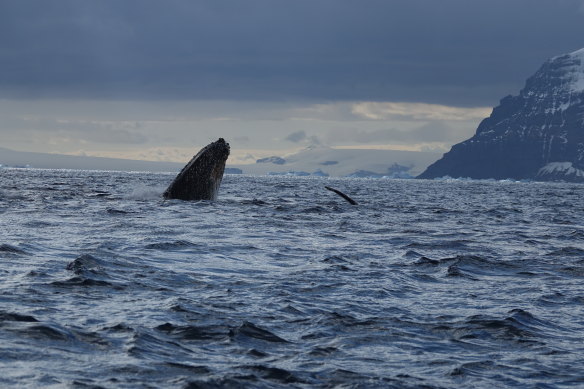
A breaching humpback whale.Credit: Courtesy of Chimu
It took a lot to get me to Antarctica the first time. I realise it’s on countless bucket lists, but as a lover of heat and light, sun and beach, the prospect of weeks at sea to reach what I envisaged as a white and empty refrigerator lacked appeal. But my husband Andrew had made a TV program there and returned in a state of dazzle and elation. We must go. I must go. After a great deal of debate – and shrewd deployment of wildlife photos – I got my thermals and waterproofs in order and agreed to spend the best part of the Australian summer journeying to the white continent with him.
It was, of course and perversely, the longest, most weather-beaten route we were taking: due south from Hobart into the tumult of the Southern Ocean, via Macquarie Island, heading for Australia’s Casey Base more than 3000 kilometres away. After some five to six weeks at sea – revelation. Far from empty, the continent pulses with life in sea, air, and especially on land, where the penguins nest in massive colonies stretching from beach to mountain-tops, as far as the eye can see. Millions of them. And as in a Disney movie, they know no fear; they’re so intensely curious, we had to back away from their advances rather than the other way round. In the sky, predator birds waited for their chance to snatch a chick, while the frigid water teemed with seals of all sizes. Whales cruised by, puffing loudly.
As for the blank, white landscape I’d expected, Antarctic ice turned out to be shafted with blue and jade, carved by wind and ocean into strange and wondrous shapes. It felt like we’d landed on a faraway but benign planet, utterly unlike anywhere we’d been before.
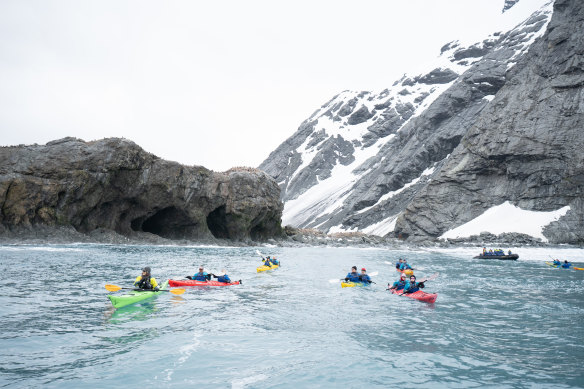
Kayakers paddle in for a closer view of the abundant sea life. A Zodiac waits nearby should anyone capsize in the freezing water.Credit: Courtesy of Chimu
This was back in the mid-1990s, and it marked the start of a long love affair. I’ve just returned from my seventh journey – a quicker one this time, just short of three weeks, taking in the Falkland Islands, South Georgia and the Antarctic Peninsula – the (relatively) warm bit that protrudes some 1300 kilometres north from the continent towards South America, and is the richest breeding ground for Antarctica’s penguins, seals and seabirds. With so much of our glorious world still to see, we planned it as our last trip to the Great White and unusually, a group of close friends came along with us. To see a place we knew and loved so deeply through their eyes was exhilarating.
The 200 or so passengers for the voyage on the Ocean Endeavour gathered at the port of Ushuaia, at the southernmost tip of Argentina, surrounded by the vast and spiky Andes – so towering and perfectly pyramid in shape, they remind you of a young child’s drawing: these be mountains. Ushuaia has grown rapidly since I first came here 30 years ago; it now bursts with cafes and trekking gear shops and a fine, newish museum focusing on Antarctica’s early explorers. But really, it’s all just a happy preamble to the journey south, summed up by the sign on the waterfront: El Fin del Mundo (The End of the World).
Some were eating, others dancing when the call went up: ‘Whales!’
I was as excited to watch our ship come in, see the bags loaded, and file on board, as I’d been the first time. But we’d scarcely left the dock when news came through that the first cases of avian flu had been detected at South Georgia, so the whole itinerary was reversed. The unexpected happens constantly in Antarctica – it always has, and more so now that our world is warming. Of course, everyone’s conscious of it. Companies like the one I travelled with, Chimu, are working on ways to minimise their environmental impact, such as alternative fuels and differently designed ships. But the changing climate is the key issue and the argument for being there has always been that every traveller to Antarctica becomes its advocate. The ship’s team of zoologists, geologists and historians give daily lectures, which are well attended except when the swell and winds rise and the tender-stomached retreat to their cabin.
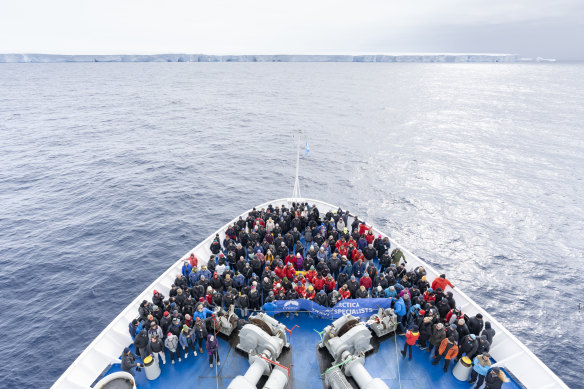
Passengers on the Ocean Endeavour.Credit: Courtesy of Chimu
My good fortune is that my dad, a British Navy man, reared me on tales of Scuppers the Sailor Dog – born at sea in the teeth of a gale – which somehow by osmosis meant that I, too, love the spray and swell of the wild water. But it calms abruptly once we reach the ice; it’s always a bit of a surprise when passengers not seen before appear for their first breakfast.
So the itinerary must respond to conditions. We’ve never travelled on the big cruise ships, only smaller and more adaptable craft; it makes for bouncier voyages when the weather turns, but given strict rules governing numbers going ashore – a maximum of 100 passengers at a time – you do get more time with your boots on the ground.
On the last two trips, we found a new and special joy: kayaking. The sturdy Ocean Endeavour carries about 10 kayaks, both singles and doubles, which come out only when conditions allow – but when they do, it’s a life high. To paddle gently through that still, chill water and to enjoy penguins and seals porpoising around you, to hear barnacle-snouted whales come up for air with a loud whoosh just metres away, to see two different species of birds sharing their nesting grounds, their young chicks peeping for more food, well, these are all such magic moments. Yes, a little nerve-wracking knowing that should you capsize, your blood would freeze within minutes, but there’s always a Zodiac nearby ready to haul you out.
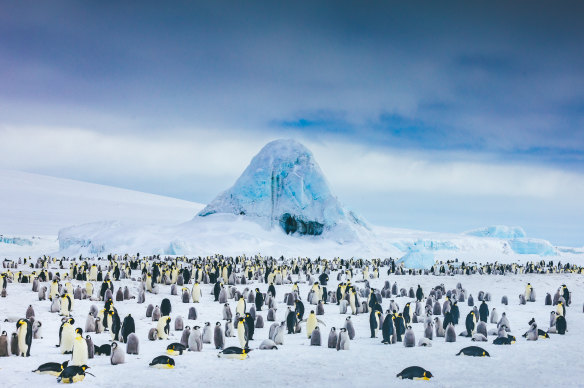
Antarctica teems with wildlife, including emperor penguins.Credit: Getty Images
These Zodiacs are the ice equivalent of desert camels. Sturdy, a little tricky to get on and off, but essential. They ferry travellers to and from the shore in relays, and as the hours of light lengthen, we land more often. We visit the hulking, rusty remnants of old whaling stations, where slaughtered whales and penguins were boiled in vats known, ugh, as “digesters”, their oil used to light lamps and lubricate machines.
We walk through light snow to the foot of the uncharted mountains crossed by Ernest Shackleton and his crew after their ship, Endurance, was trapped in pack ice and sank in 1915. Despite this, Shackleton led his men to safety, and ultimately home to Britain. After his death, at his wife’s request, Shackleton’s body was buried alongside the old whalers at South Georgia’s Grytviken cemetery. I remember on a previous trip standing by Shackleton’s grave with a crusty former whaling captain, who raised a whisky and shed a few tears in remembrance of his hero. This whaler didn’t give tuppence about whales or kayaks, this was what he came for – to salute the man known by his crew as The Boss.
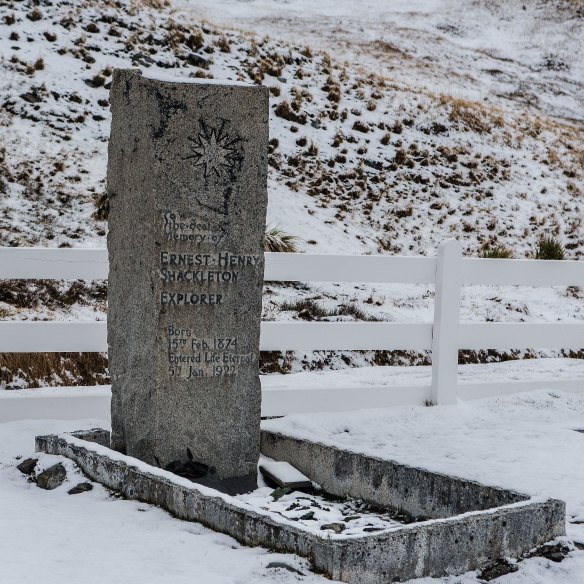
Ernest Shackleton’s grave.Credit: Alamy
A special moment for me on my latest trip was coming upon the world’s largest iceberg. Known as A23a, it’s three times the size of New York City, twice that of Greater London – so epically vast, it stretches from its fissured face far away to the horizon. It split from the Antarctic ice shelf in 1986, and after more than 30 years stuck on the ocean floor, is now drifting north through the Southern Ocean.
However, the moment of magic came when we were about two-thirds of the way through the voyage, after kitchen staff relocated the restaurant to the top deck for dinner. Some were still eating, others dancing, when the call went up: “Whales!” We all rushed to the ship’s edge to watch a pair of cruising humpbacks. They circled the ship, waving their barnacled flippers and finally, spectacularly, did a double leap into the air – as if in salute – before swimming away.
On our last morning, before turning back and heading home, we went out for our final kayak. The water was a gentle roll, the sun clear and bright. We watched penguins diving for fish all around us. We saw a wide-jawed leopard seal – Antarctica’s peak predator – busy with his hunt. On the beach, enormous elephant seals huffed and staged mock battles before collapsing into blubbery heaps. Once, they were slaughtered for their oil and fat; now, like all of Antarctica’s wildlife, they’re protected. The beauty, the sense of these free creatures going about their business, unbothered by us humans … there is simply nowhere on our beautiful blue marble like it. Maybe not our very last trip, I thought.
To read more from Good Weekend magazine, visit our page at The Sydney Morning Herald, The Age and Brisbane Times.